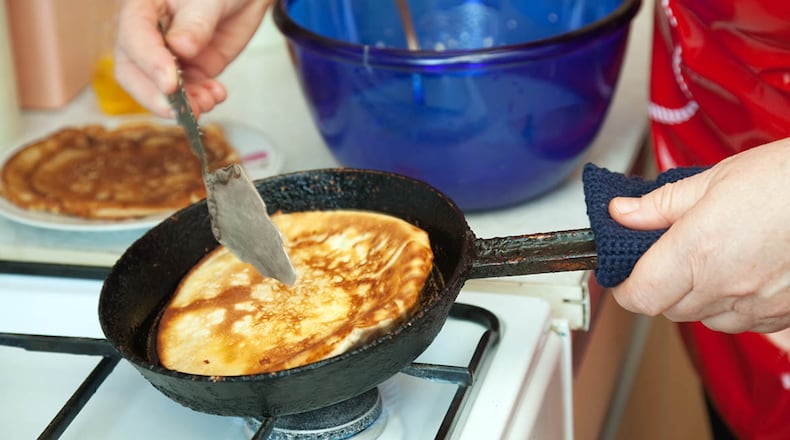As someone who shouts, “This stove is crap!” on a semi-regular basis (thanks, ancient NYC apartment appliances), I’m no stranger to burnt pancakes and still-pink-on-the-inside-after-hours-of-cooking chicken. Onions won’t brown and sunny-side up eggs refuse to unstick themselves from the pan even when turned fully upside down, making dinner impossible. But what if this wasn’t totally the stove’s fault? There are eight common (and correctable) mistakes nearly everyone makes when cooking on those hot grates.
RELATED STORIES
1. Too low or too high heat
Low heat is important for finishing egg dishes and simmering sauces, but keeping heat too low for certain dishes can can lead to sad, soggy food. When searing meat, try to get the pan as hot as possible for a few minutes without any fat. After the pan has reached the proper temperature, add butter or oil and swirl it around in the pan.
One more test before starting to cook meat is to drag the protein gently across the pan: If it sticks, the pan isn’t hot enough. Only after the meat has browned should you lower the heat and finish cooking.
Got it? Good. Now make…
Pan-Seared Orange Mustard Salmon
2. Using uneven heat.
Uneven heat (not uncommon with coiled electric stoves) is a super-quick way to mess up a dish. One side of the pan is barely simmering and the opposite is boiling so strongly it’s starting to burn. You can’t really do much about this one, unfortunately—unless you’re planning to move or replace your kitchen appliances.
If you’re finding this happens with a gas stove, the uneven heat could be caused by an open window or fan in the kitchen; thankfully that one is a pretty easy fix. Either way, you can also rotate your pans regularly as you cook… it won’t correct the problem completely, but it’s a start.
Got it? Good. Now make…
Shakshuka With Feta
3. Putting cold food in the pan
Your dinner wasn't burnt on the outside and raw inside because your stove is broken! It's because your food was too cold. Take meat out of the fridge for at least 15 minutes (but less than an hour) before throwing it into the skillet. If using frozen meat, let it defrost in the fridge—not on the counter—then do the same.
Got it? Good. Now make…
Pan-Seared Ribeye With Herb Butter
4. Stirring or flipping too often
There’s something about stovetop cooking that makes hands want to stir things every 15 seconds. And we know, whipping the pan around with a flick of your wrist to toss chopped vegetables makes you feel like a top chef. But constantly moving food around in the skillet can prevent your dinner from actually browning properly. Only stir constantly if the recipe you’re working with says so (risotto, anyone?); otherwise, step away from the chicken.
Got it? Good. Now make…
Honey-Garlic Chicken
5. Overcrowding the pan
Just like you on public transportation, food really doesn’t do well when it’s crowded. Give proteins and veg room to breathe by keeping food in one layer in a pan, preferably with a bit of space in between items. Obviously large tangles of greens are excused from this rule, but if you’re wondering why most other foods aren’t browning in the pan, this is likely the answer. Don’t have a big enough pan? Suck it up and cook in batches—it may take an extra 10 minutes, but your food will taste much, much better.
Got it? Good. Now make…
Creamy French Lentils With Mushrooms and Kale
6. Using the wrong fat
I know some healthy-eating fans keeps coconut oil on their mantles along with homemade kombucha and mason jar of manuka honey, but even this, the holiest of oils, isn’t always the answer when you’re cooking on a stove. Same goes for last decade’s fat of choice, EVOO.
While the culinary and nutritional community goes back and forth on whether heating certain oils is good for you, one thing is for sure: Good oil is expensive, and you shouldn’t waste it in the pan. A tablespoon of coconut or olive oil in the pan is perfectly fine, but when larger quantities of oil are involved, different fat works in your favor. Try a neutral (i.e., flavorless) oil like grapeseed or rice bran for cooking on the stove, and save other guys for salads and baked goods.
Got it? Good. Now make…
Garlic and Ginger-Glazed Sticky Pork
7. Using the wrong pot or pan
Ever try to fry eggs in a stainless steel pan? Make crispy sweet potato hash browns in a stockpot? Tomato sauce in a cast-iron skillet? Here’s a piece of advice: Don’t.
Using the wrong pan is one of the most common stovetop blunders; thankfully it’s also the easiest to fix. Every kitchen should have at least one stainless steel and one nonstick frying pan, and at least one pot. Cast-iron pans are really useful items for certain dishes, but unless you’re ready to commit to caring for one, you don’t actually need the hassle. Make eggs in nonstick, char potatoes in stainless steel, and let sauce bubble in a deep or wide saucepan. Your food will thank you.
Got it? Good. Now make…
Marinara Sauce
8. Making the stove do all the work
For certain meat, poultry, and fish dishes, use the stove to sear, which starts the cooking process and imparts that tasty brown crust all over the outside of the protein. Then, move the dish to the oven to fully cook. Many an egg, pasta, and vegetable dish can be improved immensely by following this method.
Got it? Good. Now make …
Honey-Braised Pork Shoulder
RECOMMENDED VIDEO: Food & Drink Magazine Kitchen Tips - Stale Bread
About the Author
Keep Reading
The Latest
Featured









